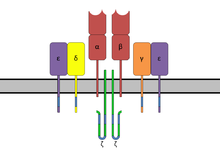Immunoreceptor tyrosine-based activation motif: Difference between revisions
consistent use of the word " cytoplasmic" |
Information about ITIM function added |
||
| Line 1: | Line 1: | ||
An '''immunoreceptor tyrosine-based activation motif''' (ITAM) (in the antagonistic case [[immunoreceptor tyrosine-based inhibitory motif|ITIM]], I for inhibition) is a conserved sequence of four [[amino acid]]s that is repeated twice in the cytoplasmic tails of certain cell surface proteins of the [[immune system]].<ref name=basic>{{citation |last1= Abbas |first1=Abul K |last2=Lichtman |first2=Andrew H. |title=Basic Immunology: Functions and Disorders of the Immune System |year=2009 |publisher=Saunders |edition=3 |place=Philadelphia, PA |isbn=978-1-4160-4688-2}}</ref> It is an integral component of the [[cell signaling|signaling]] pathway employed by [[Non-catalytic tyrosine-phosphorylated receptors]]. |
An '''immunoreceptor tyrosine-based activation motif''' (ITAM) (in the antagonistic case [[immunoreceptor tyrosine-based inhibitory motif|ITIM]], I for inhibition) is a conserved sequence of four [[amino acid]]s that is repeated twice in the cytoplasmic tails of certain cell surface proteins of the [[immune system]].<ref name=basic>{{citation |last1= Abbas |first1=Abul K |last2=Lichtman |first2=Andrew H. |title=Basic Immunology: Functions and Disorders of the Immune System |year=2009 |publisher=Saunders |edition=3 |place=Philadelphia, PA |isbn=978-1-4160-4688-2}}</ref> It is an integral component of the [[cell signaling|signaling]] pathway employed by [[Non-catalytic tyrosine-phosphorylated receptors]]. |
||
==Structure== |
==Structure== |
||
| Line 6: | Line 6: | ||
==Function== |
==Function== |
||
[[Image:TCRComplex.png|thumb|The '''T-cell receptor complex''' with TCR-α and TCR-β chains, [[CD3 receptor|CD3]] and ζ-chain accessory molecules. ITAMs are represented in blue on the tails of the CD3 subunits.]] |
[[Image:TCRComplex.png|thumb|The '''T-cell receptor complex''' with TCR-α and TCR-β chains, [[CD3 receptor|CD3]] and ζ-chain accessory molecules. ITAMs are represented in blue on the tails of the CD3 subunits.]] |
||
ITAMs are important for signal transduction in immune cells. They are found in the cytoplasmic tails of non-catalytic tyrosine-phosphorylated receptors <ref name="Dushek2012">{{cite journal| vauthors = Dushek O, Goyette J, van der Merwe PA| title = Non-catalytic tyrosine- phosphorylated receptors | journal = Immunological Reviews| volume = 250 | issue = 1| pages = 258–276 | date = November 2012| pmid = 23046135| pmc = | doi = 10.1111/imr.12008 | postscript = }}</ref> such as the [[CD3 receptor|CD3]] and [[ζ-chain]]s of the [[T cell receptor]] complex,<ref name=basic/> the [[CD79]]-alpha and -beta chains of the B cell receptor complex, and certain [[Fc receptor]]s. <ref name="Dushek2012"/> The tyrosine residues within these motifs become phosphorylated by [[Src family kinase]]s (SFK) following interaction of the receptor molecules with their [[ligand]]s. Phosphorylated ITAMs serve as docking sites for other proteins containing a [[SH2 domain]] |
ITAMs are important for signal transduction in immune cells. They are found in the cytoplasmic tails of non-catalytic tyrosine-phosphorylated receptors <ref name="Dushek2012">{{cite journal| vauthors = Dushek O, Goyette J, van der Merwe PA| title = Non-catalytic tyrosine- phosphorylated receptors | journal = Immunological Reviews| volume = 250 | issue = 1| pages = 258–276 | date = November 2012| pmid = 23046135| pmc = | doi = 10.1111/imr.12008 | postscript = }}</ref> such as the [[CD3 receptor|CD3]] and [[ζ-chain]]s of the [[T cell receptor]] complex,<ref name=basic/> the [[CD79]]-alpha and -beta chains of the B cell receptor complex, and certain [[Fc receptor]]s. <ref name="Dushek2012"/> The tyrosine residues within these motifs become phosphorylated by [[Src family kinase]]s (SFK) following interaction of the receptor molecules with their [[ligand]]s. Phosphorylated ITAMs serve as docking sites for other proteins containing a [[SH2 domain]] inducing a signaling cascade resulting in the activation of the immune cell. |
||
Other non-catalytic tyrosine-phosphorylated receptors carry a conserved inhibitory motif ([[immunoreceptor tyrosine-based inhibitory motif|ITIM]]) that, when phosphorylated, results in the inhibition of the signaling pathway. |
|||
==References== |
==References== |
||
Revision as of 13:19, 4 December 2019
An immunoreceptor tyrosine-based activation motif (ITAM) (in the antagonistic case ITIM, I for inhibition) is a conserved sequence of four amino acids that is repeated twice in the cytoplasmic tails of certain cell surface proteins of the immune system.[1] It is an integral component of the signaling pathway employed by Non-catalytic tyrosine-phosphorylated receptors.
Structure
The motif contains a tyrosine separated from a leucine or isoleucine by any two other amino acids, giving the signature YxxL/I.[1] Two of these signatures are typically separated by between 6 and 8 amino acids in the cytoplasmic tail of the molecule (YxxL/Ix(6-8)YxxL/I).
Function

ITAMs are important for signal transduction in immune cells. They are found in the cytoplasmic tails of non-catalytic tyrosine-phosphorylated receptors [2] such as the CD3 and ζ-chains of the T cell receptor complex,[1] the CD79-alpha and -beta chains of the B cell receptor complex, and certain Fc receptors. [2] The tyrosine residues within these motifs become phosphorylated by Src family kinases (SFK) following interaction of the receptor molecules with their ligands. Phosphorylated ITAMs serve as docking sites for other proteins containing a SH2 domain inducing a signaling cascade resulting in the activation of the immune cell.
Other non-catalytic tyrosine-phosphorylated receptors carry a conserved inhibitory motif (ITIM) that, when phosphorylated, results in the inhibition of the signaling pathway.
References
- ^ a b c Abbas, Abul K; Lichtman, Andrew H. (2009), Basic Immunology: Functions and Disorders of the Immune System (3 ed.), Philadelphia, PA: Saunders, ISBN 978-1-4160-4688-2
- ^ a b Dushek O, Goyette J, van der Merwe PA (November 2012). "Non-catalytic tyrosine- phosphorylated receptors". Immunological Reviews. 250 (1): 258–276. doi:10.1111/imr.12008. PMID 23046135.
